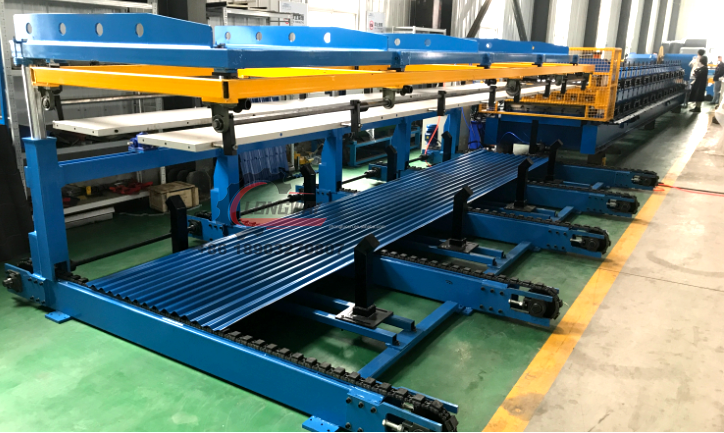Manufacturers of Corrugated Steel Sheet Production Equipment and Machinery Solutions
The Rise of Corrugated Steel Sheet Making Machine Factories
In recent years, the construction industry has seen a significant evolution, with corrugated steel sheets becoming increasingly popular due to their durability, cost-effectiveness, and versatility. This growing demand has led to the emergence and expansion of corrugated steel sheet making machine factories around the globe. These facilities not only play a crucial role in manufacturing but also represent an intersection of technology, innovation, and sustainability in modern construction practices.
What are Corrugated Steel Sheets?
Corrugated steel sheets are formed by pressing metal sheets into a series of parallel ridges and valleys. This unique shape enhances their strength, making them ideal for various applications, including roofing, wall cladding, and flooring. The corrugation process increases the surface area, improving the load-bearing capabilities and making them resistant to environmental factors such as wind, rain, and snow. Additionally, they are lightweight, which simplifies transportation and installation.
The Role of Corrugated Steel Sheet Making Machines
The manufacturing of corrugated steel sheets requires sophisticated machinery that can handle the raw materials efficiently. Modern corrugated steel sheet making machines are designed to deliver precision, speed, and consistency in production. These machines typically consist of a few key components a decoiler, a roll forming unit, a cutting station, and sometimes a printing mechanism.
1. Decoiler This unit unwinds the steel coils, preparing them for processing. A high-quality decoiler ensures that the steel sheet is fed smoothly into the roll forming machine.
2. Roll Forming Unit This is the heart of the operation, where the flat steel sheets are transformed into corrugated shapes. Advanced CNC technology allows for precise control over the dimensions and shapes of the corrugation, ensuring that each sheet meets specific industry standards.
3. Cutting Station After forming, the sheets are cut to the required lengths. Automated cutting mechanisms reduce waste and increase efficiency, allowing factories to maximize their output.
4. Optional Printing Some machines include features for printing patterns or information directly onto the steel sheets, enhancing their aesthetic appeal and providing essential details for identification.
corrugated steel sheet making machine factories

Technological Advances
The corrugated steel sheet making machine industry is witnessing rapid technological advancements. Automation and robotics are increasingly integrated into production lines, increasing efficiency and reducing the need for manual labor. This shift not only lowers production costs but also minimizes human error, ensuring that the final products meet quality specifications.
Additionally, innovations in materials and design are enabling manufacturers to produce lighter yet stronger sheets. The advent of computer-aided design (CAD) allows for customized solutions tailored to specific client needs, paving the way for more specialized and niche applications within the market.
Environmental Considerations
Sustainability is becoming a critical factor in industrial production, and the corrugated steel sheet industry is no exception. Many factories are adopting eco-friendly practices by reducing waste and energy consumption during the manufacturing process. Recycling scrap metal is also a common practice, with many manufacturers using up to 90% recycled materials in their production lines.
Furthermore, corrugated steel sheets themselves are highly recyclable, making them an attractive choice for environmentally conscious builders and developers. The durability of steel means that these sheets can have a long life span, further contributing to sustainability goals.
Market Trends and Challenges
As the global demand for corrugated steel sheets continues to rise, driven by rapid urbanization and infrastructural development, factories are expanding their operations to keep pace. However, challenges such as fluctuating raw material prices, trade tariffs, and the need for skilled labor persist. Factories must remain agile, adapting to market dynamics while investing in workforce training and development.
Conclusion
The evolution of corrugated steel sheet making machine factories marks a significant development in the construction materials sector. These factories are not only meeting the demands for durable and flexible building materials but are also paving the way for a more sustainable future in construction. By leveraging advanced technology and innovative practices, they are well-positioned to play a crucial role in shaping our modern built environment. As the industry continues to evolve, it will be exciting to see how corrugated steel sheets will contribute to the skyline of our cities and the infrastructure of our communities.
-
Roof Panel Machines: Buying Guide, Types, and PricingNewsJul.04, 2025
-
Purlin Machines: Types, Features, and Pricing GuideNewsJul.04, 2025
-
Metal Embossing Machines: Types, Applications, and Buying GuideNewsJul.04, 2025
-
Gutter Machines: Features, Types, and Cost BreakdownNewsJul.04, 2025
-
Cut to Length Line: Overview, Equipment, and Buying GuideNewsJul.04, 2025
-
Auto Stacker: Features, Applications, and Cost BreakdownNewsJul.04, 2025
-
Top Drywall Profile Machine Models for SaleNewsJun.05, 2025








